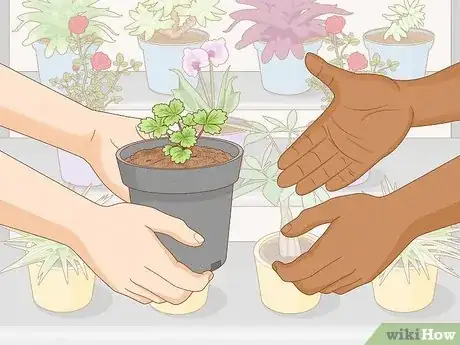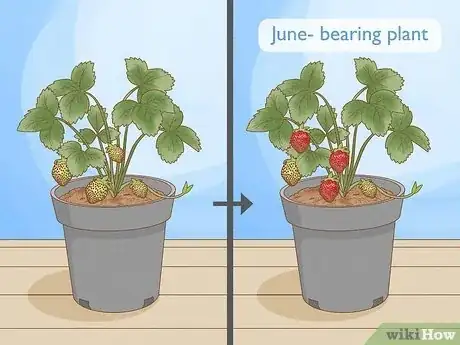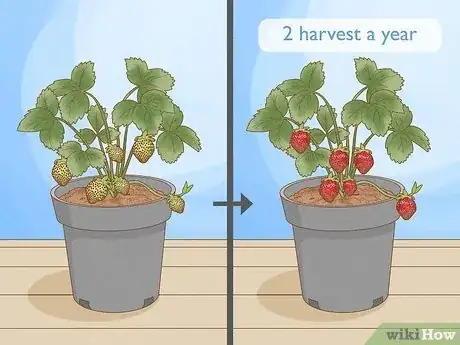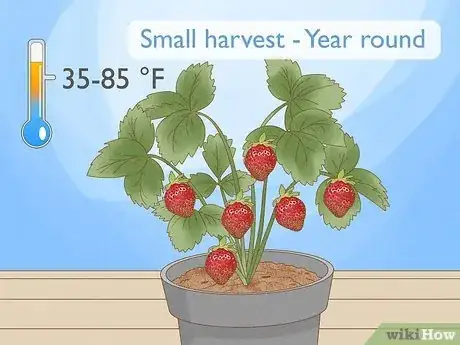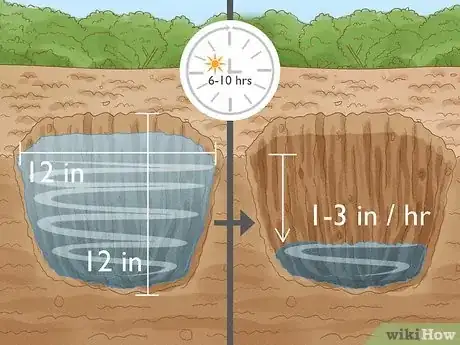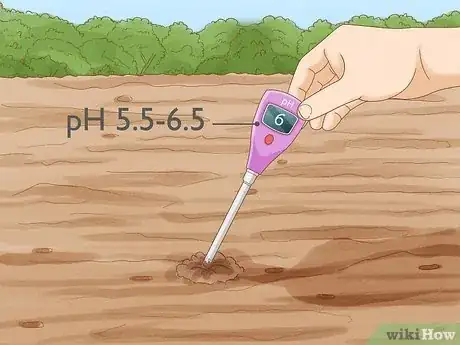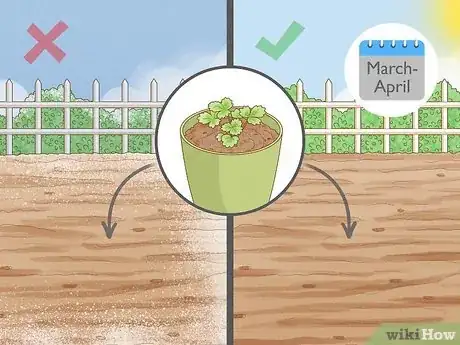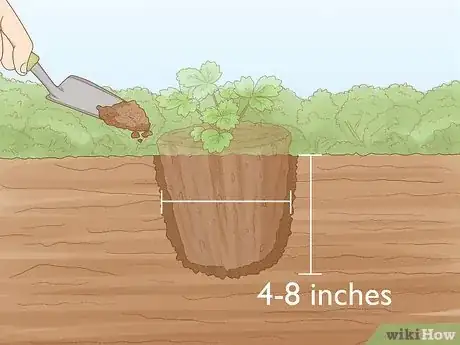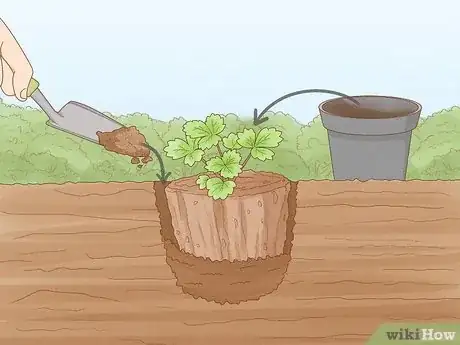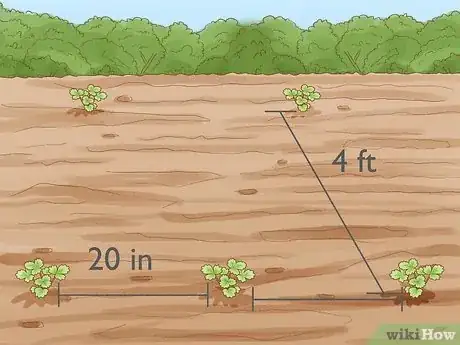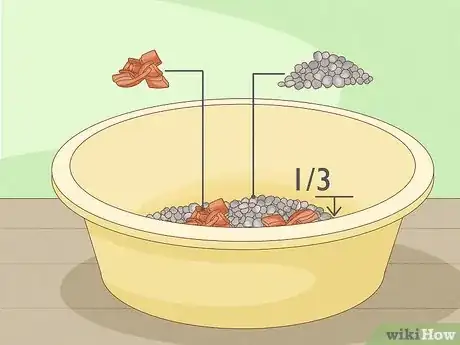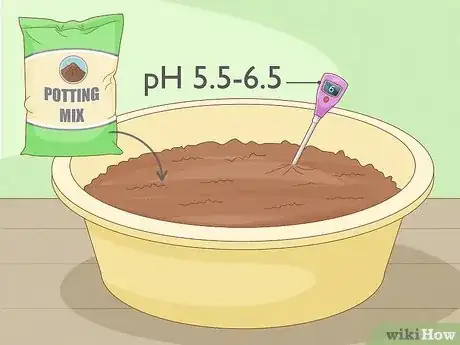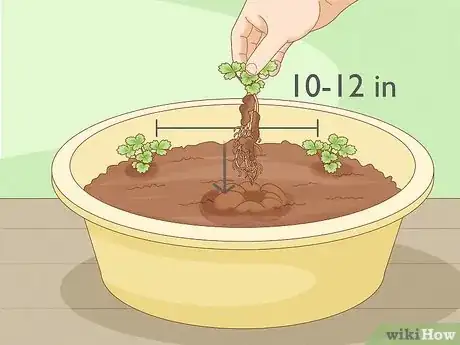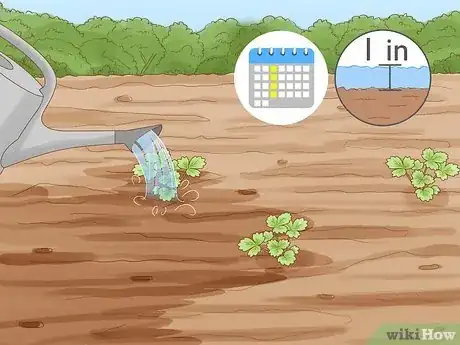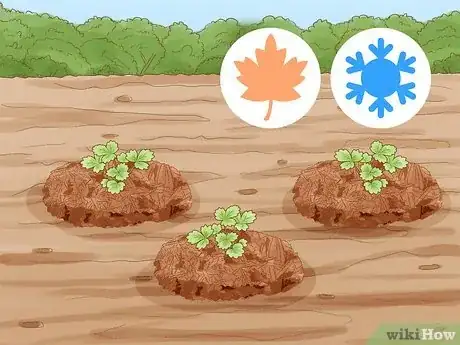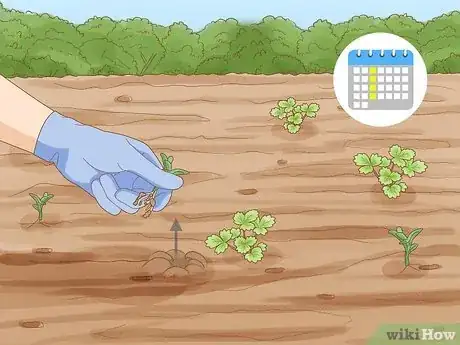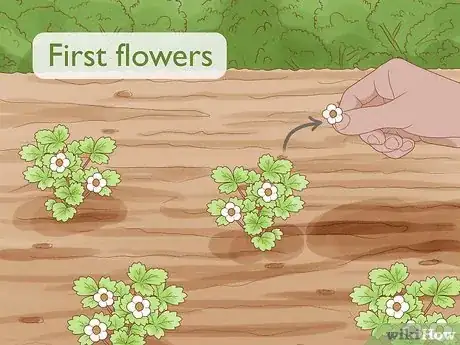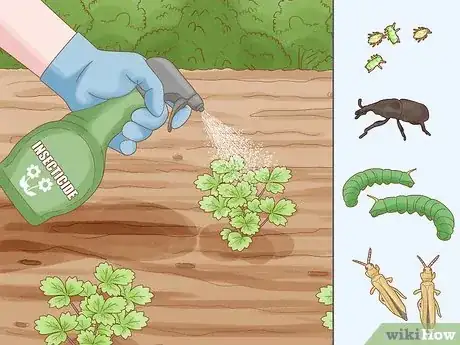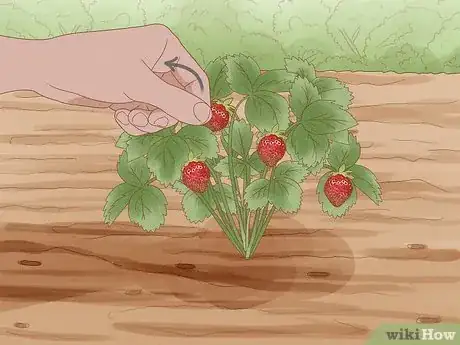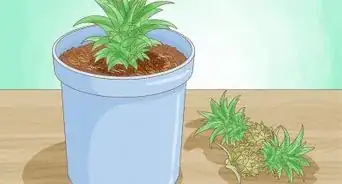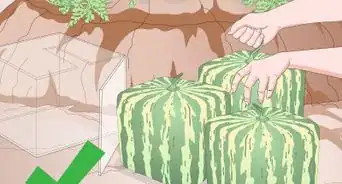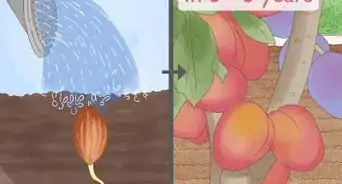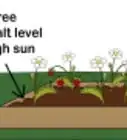This article was co-authored by Maggie Moran. Maggie Moran is a Professional Gardener in Pennsylvania.
There are 16 references cited in this article, which can be found at the bottom of the page.
wikiHow marks an article as reader-approved once it receives enough positive feedback. This article received 34 testimonials and 80% of readers who voted found it helpful, earning it our reader-approved status.
This article has been viewed 995,769 times.
As both a food and a decorative plant, strawberries provide an abundance of beautiful red berries for around 5 years. Strawberries are rarely grown from seed. Instead, purchase a strawberry plant or runner from a nursery. Put this out in your garden or in a container for a tasty harvest the next year.
Steps
Choosing Your Plant
-
1Buy a small strawberry plant or runner from a garden store or nursery. You can either purchase a pot-grown plant from a nursery or get runners from a nursery or mail-order garden store.[1]
- Pot-grown plants are young strawberry plants that are already established and grown a little. You can sometimes get berries the same year as you plant it, although you may need to wait a year for a full harvest.
- Runners are generally a cheaper option. These are seedlings with long roots that are taken from other strawberry plants. These may take a little longer to grow in your garden and to produce a harvest.
-
2Get a June-bearing plant if you want 1 large harvest a year. A June-bearing plant will give you the most strawberries, but it only produces berries once a year in June. Purchase this variety if you're looking to preserve or freeze your harvest.[2]
- There are several varieties of June-bearing strawberries. These include Earliglow, Seneca, and Allstar. Ask the nursery or your local extension office which type is recommended for your region.
Advertisement -
3Pick an everbearing plant for 2 moderate harvests a year. This plant will grow and produce a fair amount fruit in spring and autumn. You will get more harvests a year, but these will be smaller than June-bearing.[3]
- Varieties of everbearing include EverSweet and Ozark Beauty.
-
4Select a day-neutral plant if you want small harvests year-round. These plants may produce strawberries throughout the year as long as the temperature is between 35–85 °F (2–29 °C), but the harvests are very small.[4]
- Varieties of day-neutral include Tristar and Tribute.
Planting the Strawberries in a Garden
-
1Choose a sunny, well-draining spot in your garden. Look for a spot that will give your strawberry bush 6-10 hours of direct sunlight a day. The soil should absorb water easily as well. Avoid any areas where there is standing water.[5]
- To test the drainage of the soil, dig a 12 by 12 inches (30 cm × 30 cm) hole and fill it with water. The next day, fill it again with water and test how long it takes to drain. Ideally, it should drain about 1–3 inches (2.5–7.6 cm) an hour.[6]
- Do not plant the strawberries in an area where you have grown tomatoes, potatoes, peppers, or eggplants in the past 4 years, as these may spread fungus to your plants.
-
2Look for soil with a pH between 5.5 and 6.5. Get a soil testing kit from a local nursery or county extension office. Follow the instructions on the label to learn the pH. The soil should be slightly acidic.[7]
- If the pH of your soil is wrong, you will need to amend it. If the pH is too low, mix lime or small amounts of dolomitic limestone into the soil. If the pH is too high, add sulfur or peat moss into the soil.
-
3Plant the strawberries after the last frost in March or April. As soon as the ground is no longer frozen, and you do not expect another frost, you can plant strawberries. This is usually in March or April, although you should look up the frost dates for your area.[8]
- You should be able to easy dig through the soil with a trowel. If the ground is still hard, wait a few weeks.
- The soil should be dry. If it rains, wait a few days before trying to plant the strawberries.
-
4Dig a hole that is deep and wide enough for the roots. Generally, the hole will be between 4–8 inches (10–20 cm) deep, depending on how long the roots are. If the plant is in a pot, use the pot as a guideline for how deep the hole should be.[9]
-
5Move the strawberry plant from the pot into the hole. Remove the strawberry from its original pot, being careful to keep the roots intact. Place the roots in the soil. Push soil over the roots so that the tops are just covered. Water the plant immediately.[10]
- Only cover the roots with soil. The crown (or thick green stem) should remain above the soil.
-
6Place each strawberry plant 20 inches (51 cm) away from each other. If you have more than 1 row of strawberry plants, keep the rows 4 feet (1.2 m) apart. This gives the plants plenty of room to sprawl and grow.[11]
Raising Strawberries in a Container
-
1Choose a large potting container with drainage holes. The container should have a diameter of 16–18 inches (41–46 cm) to let the plant grow. The holes on the bottom will ensure that the soil drains properly.[12]
-
2Fill the bottom of the pot with bottles, small rocks, or broken pottery. Fill about 1/3 of the pot. Drape landscape fabric over the items. This will help the soil drain properly. The strawberry plant has rather shallow roots, so it does not need the whole pot filled with soil.[13]
- This will also make the container less heavy, which will help if you need to move the container.
-
3Fill the remaining space with potting mix. Use a multipurpose potting soil with a pH between 5.5 and 6.5. Leave enough space in the container for you to plant the strawberries. If desired, you can add compost to enrich the soil.[14]
- The label of the potting mix should state its pH.
-
4Transplant the strawberries into the pot. Remove the strawberry from its original pot. Gently loosen the soil around the roots with your fingers, but try not to touch or disturb the roots. Set the plant into the hole in the pot. Push or add more soil to cover the tops of the roots.[15]
- The crown of the plant should remain above the soil. Only the roots should be under the soil.
- If you have a large pot or growing container for multiple plants, keep the strawberries about 10–12 inches (25–30 cm) apart.
-
5Place the pots in a sunny area. Strawberries need 6-10 hours of direct sunlight a day. Put your pots out on a porch, in a garden, or on a balcony where they can get enough sunshine. You can bring the pots in during the winter, as long as you leave them by a sunny window. [16]
- If you can’t get enough sunlight indoors for your strawberry plant, try putting the plant under a grow light.
Caring for Strawberry Plants
-
1Water regularly. Give about 1 inch (2.5 cm) of water each week. Water the base of the plant. Avoid watering fruit and leaves, as this could cause the plant to develop fungus or rot.[17]
- For a rough estimate of how much water you need, use about 5 gallons (19 L) of water for every 8 feet (2.4 m) of strawberry plants.
-
2Add mulch in autumn to protect the roots from frost. Spread the mulch around the base of the plants. You can use straw, pine needles, or wood shavings. Remove the mulch in spring and spread it between the rows to keep the area free of weeds.[18]
-
3Weed around the strawberry plants. Weeds can easily overwhelm strawberry plants, especially newly planted ones. Check for weeds once a week. Pull out any weeds by hand, making sure to remove their roots. You can also use a hoe to remove weeds between rows.[19]
-
4Pluck off the first flowers. By removing the first flowers that appear, you will give the strawberry plant a chance to grow more vigorously. You can pull the flowers off or cut them off using gardening shears.[20]
- For June-bearing plants, remove all flowers in the first year to get a harvest the following year. The next year, do not remove the flowers.
- For day-neutral and everbearing varieties, remove the flowers until the end of June. Allow flowers to grow afterwards for a fall harvest.
-
5Prevent pests by using insecticides. A wide range of insects enjoy strawberries, including caterpillars, beetles, aphids, and thrips. To keep these at bay, use insecticidal soaps or spray-on neem products on the plants. Read the label to make sure that these are safe for home use.[21]
- Always follow the instructions on the label of the insecticide for proper use.
- Drape nets over the strawberries to keep birds from eating them.
-
6Apply a fungicide on the plant to keep disease at bay. Strawberries are susceptible to many types of fungus, such as powdery mildew or grey mold. Buy a fungicide labeled for home use. It should state on the label if it is safe for strawberries. Follow the instructions on the label to use.[22]
- If you notice any discolored or spotted leaves, pull or cut them off the plant to prevent the spread of disease.
-
7Harvest the strawberries. When ¾ of the strawberry is red, it's ready to pick. Take a bowl or basket to your plant or strawberry patch. Twist the stem to pick it from the bush. Wash the strawberries in cool water before eating.[23]
- Harvest your fruit as soon as it is ripe; strawberries that sit on top of the soil too long will rot.
- Remove strawberries that have started to rot from the plant. It is better to throw them out than to leave them on the plant.
Expert Q&A
Did you know you can get expert answers for this article?
Unlock expert answers by supporting wikiHow
-
QuestionHow do I grow strawberry plants?
 Maggie MoranMaggie Moran is a Professional Gardener in Pennsylvania.
Maggie MoranMaggie Moran is a Professional Gardener in Pennsylvania.
Home & Garden Specialist
-
QuestionCan you start a strawberry plant from a strawberry?
 Maggie MoranMaggie Moran is a Professional Gardener in Pennsylvania.
Maggie MoranMaggie Moran is a Professional Gardener in Pennsylvania.
Home & Garden Specialist
-
QuestionHow long does it take for a strawberry plant to produce fruit?
 Maggie MoranMaggie Moran is a Professional Gardener in Pennsylvania.
Maggie MoranMaggie Moran is a Professional Gardener in Pennsylvania.
Home & Garden Specialist
Things You’ll Need
Planting the Strawberries in a Garden
- Pot-grown plant or runner
- Trowel
- Soil testing kit
- Hose or watering can
Raising Strawberries in a Container
- Pot-grown plant or runner
- Planting pot or container
- Strawberry plant or runner
- Potting soil
- Trowel
- Grow light (optional)
Caring for Your Strawberries
- Hose or watering can
- Gardening shears
- Hoe
- Mulch
- Insecticidal soap or neem
- Fungicide
- Nets
References
- ↑ https://www.almanac.com/plant/strawberries
- ↑ https://www.almanac.com/plant/strawberries
- ↑ https://www.almanac.com/plant/strawberries
- ↑ https://www.almanac.com/plant/strawberries
- ↑ https://extension.umaine.edu/publications/2067e/
- ↑ https://extension.tennessee.edu/Williamson/Horticulture/Consumer%20Horticulture/DIY%20Soil%20Drainage%20Perk%20Test%20for%20Your%20Yard%20(2016).pdf
- ↑ http://edis.ifas.ufl.edu/hs403
- ↑ https://extension.illinois.edu/strawberries/growing.cfm
- ↑ https://extension.illinois.edu/strawberries/growing.cfm
- ↑ https://extension.illinois.edu/strawberries/growing.cfm
- ↑ https://www.almanac.com/plant/strawberries
- ↑ https://garden.org/learn/articles/view/4058/
- ↑ https://garden.org/learn/articles/view/4058/
- ↑ https://www.growveg.com/guides/how-to-grow-strawberries-successfully-in-containers/
- ↑ https://www.growveg.com/guides/how-to-grow-strawberries-successfully-in-containers
- ↑ https://extension.umaine.edu/publications/2067e/
- ↑ https://www.almanac.com/plant/strawberries
- ↑ https://extension.umaine.edu/publications/2067e/
- ↑ https://www.almanac.com/plant/strawberries
- ↑ https://extension.illinois.edu/strawberries/growing.cfm
- ↑ http://edis.ifas.ufl.edu/hs403
- ↑ http://edis.ifas.ufl.edu/hs403
- ↑ http://edis.ifas.ufl.edu/hs403
About This Article
To grow strawberries, start by purchasing a small strawberry plant or runner from your local garden store. If you want to preserve or freeze your harvest, choose a June-bearing plant for 1 large harvest a year. Alternatively, select a day-neutral plant for small harvests all throughout the year. Plant your strawberries in a container filled with potting mix, or in a sunny, well-draining spot in your garden. Afterwards, water the strawberries regularly to keep the soil moist, and pull out any weeds by hand, making sure to remove them by the roots. For more advice, including how to protect your strawberries from fungus or rot, keep reading.
